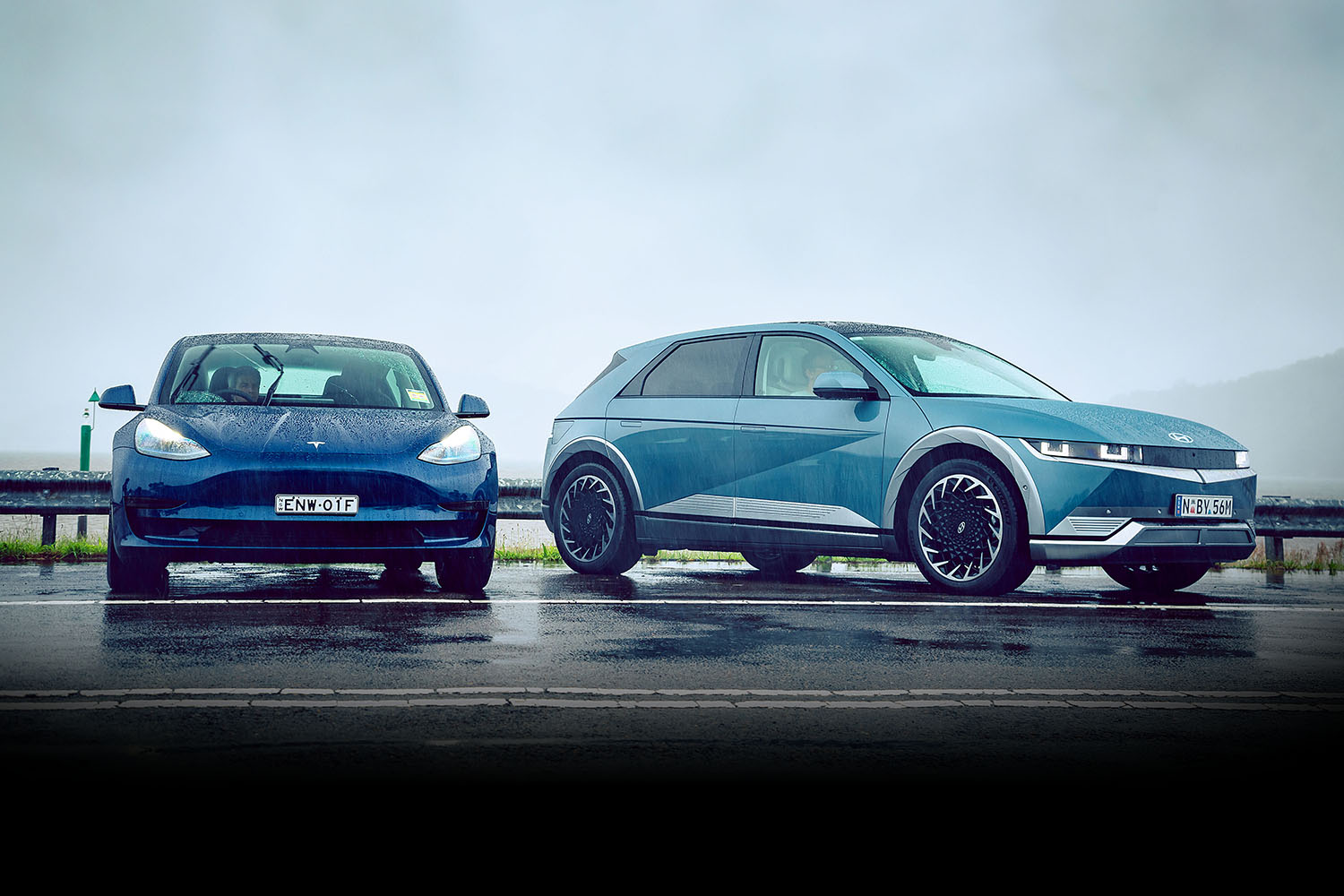For an exponent of silent motoring, the Hyundai IONIQ 5 is making quite a noise.
The buzz surrounding the South Korean EV has nothing to do with its new dedicated battery electric vehicle platform that shares 800-volt rapid-charging capability with the Porsche Taycan and will underpin a large assortment of Hyundai Group models.
Instead, it has everything to do with the crossover’s stunning retro-futuristic design – a metallic origami of chiselled panels and creases that combine with glorious details such as pixelated cubic LED head- and tail-lights, door strakes, and the first clamshell bonnet seen on a Hyundai.
The short-overhanged, five-door body with a limousine-like three-metre wheelbase also disguises a footprint only slightly longer than the company’s Tucson mid-sized SUV and virtually as wide as the Santa Fe seven-seater SUV.
It’s essentially a mega-hatch that’s just 59mm shorter than the mid-sized electric sedan everyone now wants to beat, regardless of vehicle style.
Looking elegant from some angles, strange from others, and somewhat plain in the Hyundai’s company, the Tesla Model 3 – first introduced in 2017 – makes for more remarkable viewing in the sales charts. Not merely the best-selling electric vehicle globally (and locally, if unofficially), the smallest Tesla is now among the most popular cars in the world.
NOTE: Click any of the photos here to enter our gallery

Pricing and features
Earlier this year, perhaps in preparation for new competition, Tesla sharpened Model 3 prices by up to 12 percent.
Significantly, the cost of entry to a Tesla dropped below $60,000 with our $59,900 Standard Range Plus.
And while the best EV incentives currently available in Australia (NSW) can effectively wipe out its on-road charges, the IONIQ 5’s $71,900 starting price excludes it from the generous $3000 rebates offered by both NSW and Victoria.
There’s potential for a sub-$65,000 IONIQ 5 in 2022, but Hyundai Australia has for now opted to attract customers with a fully loaded Highlander-style specification.
A $75,900 IONIQ 5 AWD with dual motors is also available, adding significant performance but subtracting some battery range. Here we have the single-motor RWD model to mirror the Model 3 Standard Range Plus.
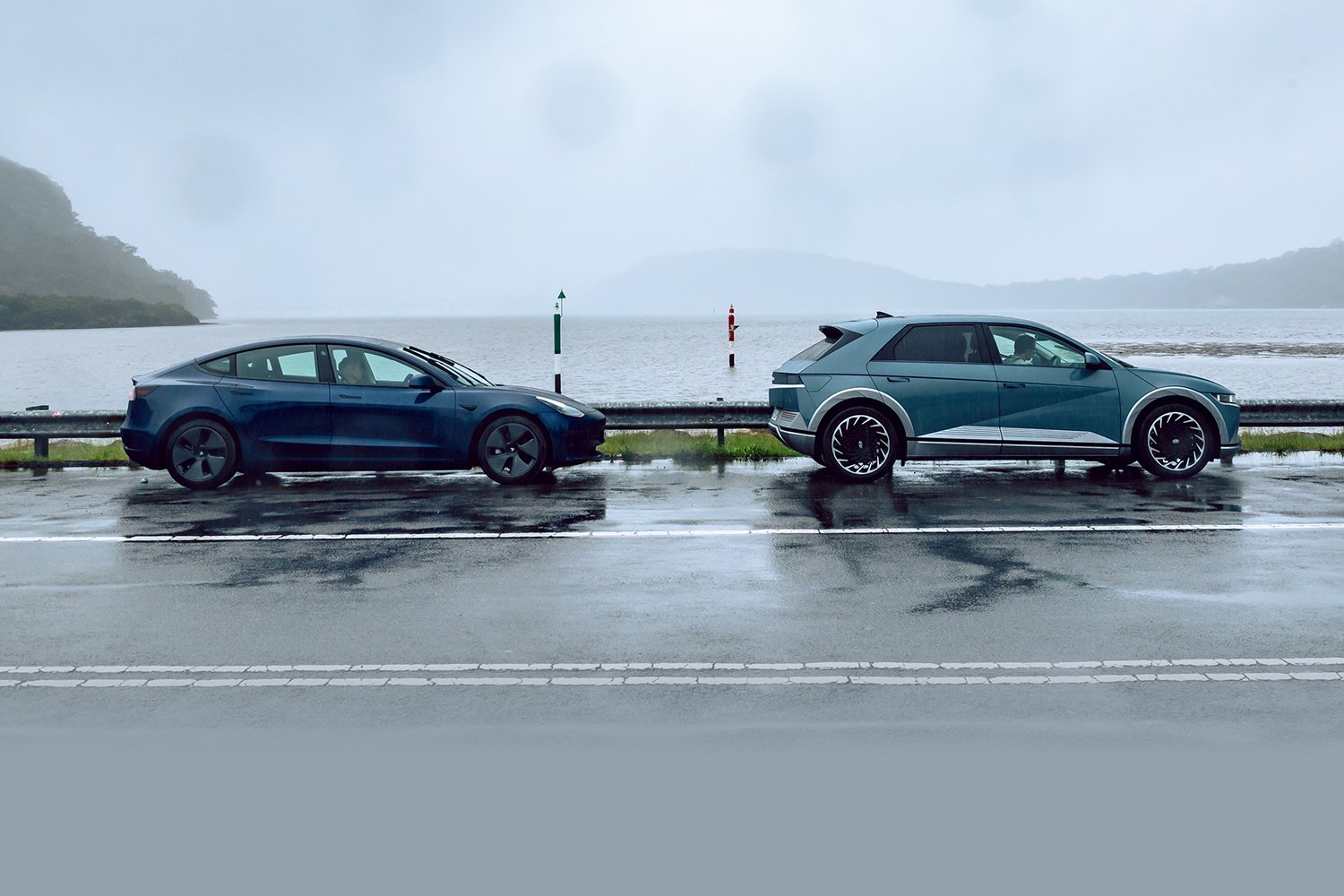
Features the basic Model 3 can’t match on the Hyundai include metallic paint, 20-inch alloy wheels, 3D Surround View, semi-auto parking, Bose Audio system, leather-appointed interior, front seats with a full recliner setting plus heating/ventilation, heated rear seats, heated steering wheel, and LED interior lighting.
Higher-grade Model 3 variants add features while increasing range and performance, but the price gap can be wiped out in one fell swoop if the $10,100 box is ticked for Tesla’s contentiously titled Full Self Driving Capability suite, which offers questionable benefits over the standard Autopilot system.
Regular over-the-air software updates help protect the Model 3 from obsolescence (and allow for the purchase of feature upgrades), though in late 2020 Tesla introduced a bunch of physical MY21 updates.
Production for Australian models has also switched from the US to China, and the Standard Range Plus, specifically, swapped to a new battery chemistry with lifecycle, safety and ethical advantages.

Interior and infotainment
Interior changes were subtle, so the Model 3’s starkly stylish, ultra-minimalist cabin design remains. Steering wheel, pedals, wiper/transmission stalks and window switches aside, all functions for the car – including side mirror adjustments – are controlled via the 15-inch supersized-tablet central touchscreen.
It’s not quite as beautifully intuitive as an Apple product on initial acquaintance, but there’s immense depth to the Tesla’s content-rich infotainment system. A $9.99 monthly subscription is required for the full complement, but it rewards with Easter-egg features the further you explore.
Driving games that you can play using the Tesla’s steering wheels and pedals (when parked, naturally), a Karaoke mode, as well as the good old whoopee-cushion effect continue to remind us that Elon Musk has a sense of humour.
An important update for the interior includes a redesigned centre console that introduces suede-backed dual charging pads for smartphones (which are super-quick at replenishing the battery).
There’s a couple more fast-charging USB-C ports and the glovebox – yep, also opened via the touchscreen – now features a USB-A port to which a storage fob can be connected for Sentry Mode security and Dash Cam footage.
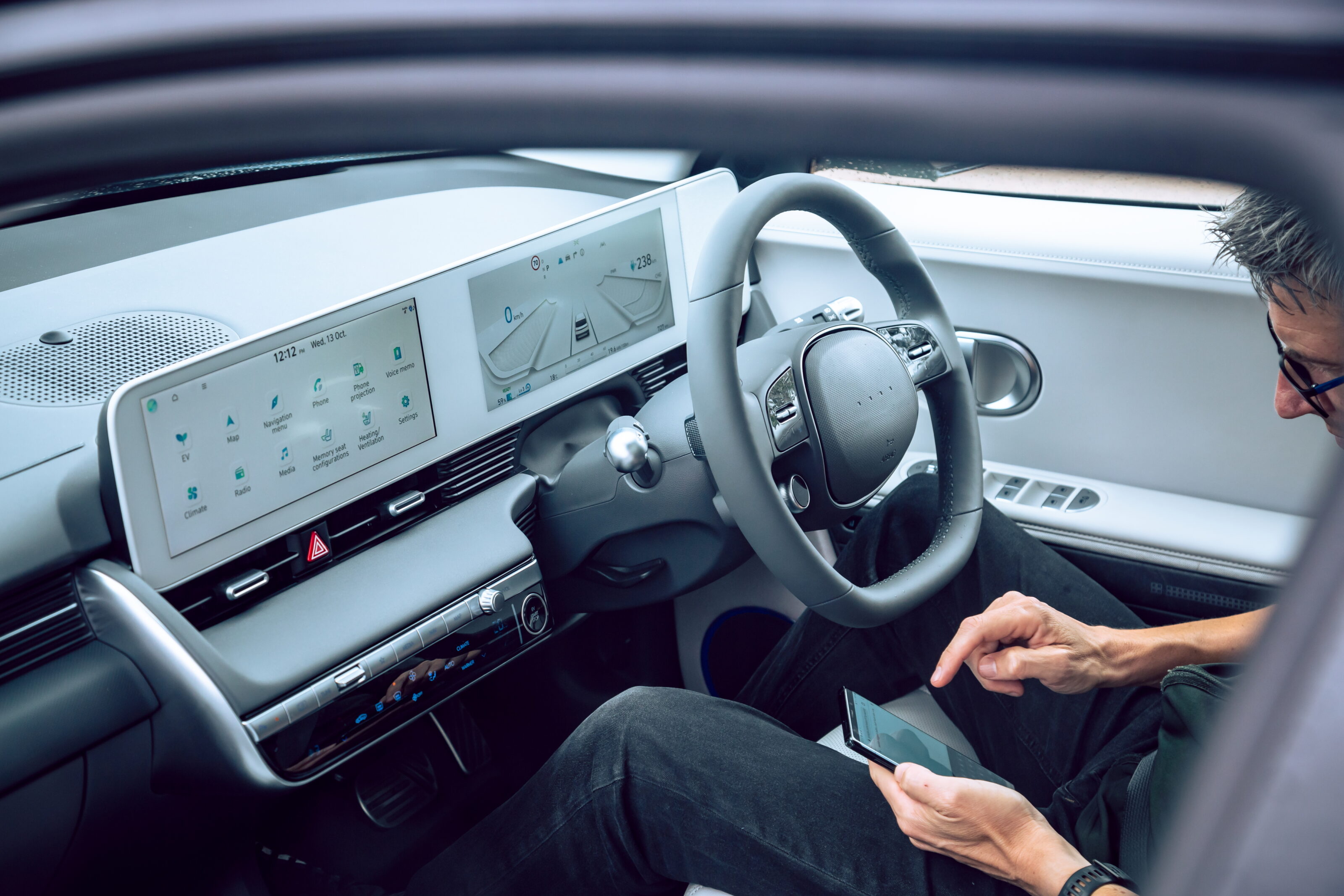
The Hyundai’s interior isn’t as visually arresting as its exterior, and its dashboard – with its Mercedes-mimicking conjoined 12.3-inch digital displays, separate climate control panel and visible vents – looks positively conventional after the Tesla. The screen resolutions are sharp, and the graphics palette, if rather anaemic, helps create some differentiation from the otherwise familiar Hyundai Group interface.
The infotainment menu includes a dedicated EV information page, with battery life and driving range shown on the driver display that also includes a clever blind-spot video feed. The driver cluster otherwise disappoints with its lack of customisation. If the IONIQ 5 can’t match the Model 3 for cabin technology (including slower-charging USB-A ports), it trumps the Tesla in every other interior criterion: space, comfort and quality.
While both vehicles sit their cabins atop a skateboard platform with integrated battery to create fully flat floors, the Hyundai feels even more open – and suffused in light when the expansive glass roof is revealed.
Where the Tesla opts for a fixed centre console with generous storage sections, the Hyundai’s console slides with 140mm of travel to create a clear walk-through between the front seats.

The IONIQ’s console is more convenient with its open-storage area that takes a small bag or even a pair of shoes, and the ingenious filing-draw glovebox fits a 13-inch laptop. There’s also greater electric adjustment for the front seats in the IONIQ 5, including full reclining with calf-rests for owners who want to relax inside while the car fast-charges.
The Hyundai’s rear seat, accessed by a huge rear door that wasn’t necessarily designed with busy car parks in mind, offers the vast space promised by the IONIQ’s protracted wheelbase. Passengers are further pampered with a 60-40 bench that slides electrically, seatbacks that offer manual recline adjustment, window shades, pillar vents and plentiful rear storage.
The Model 3’s rear cabin is a short-straw experience for adults, with comfort compromised in a similar way to the larger Model S. The combination of a low-set bench and sloping roof creates a knees-up posture and, for anyone over 178cm, limits headroom markedly. Squashed toe space confirms this as a place best for kids.
Huge glass sunroofs are shared but different in concept. Dual-pane and heavily tinted in the Tesla; one-piece in the Hyundai with a thick blind comprising front/rear sections that meet smartly in the middle. For hotter climes, Model 3 owners might want to invest in the optional sunroof shade.
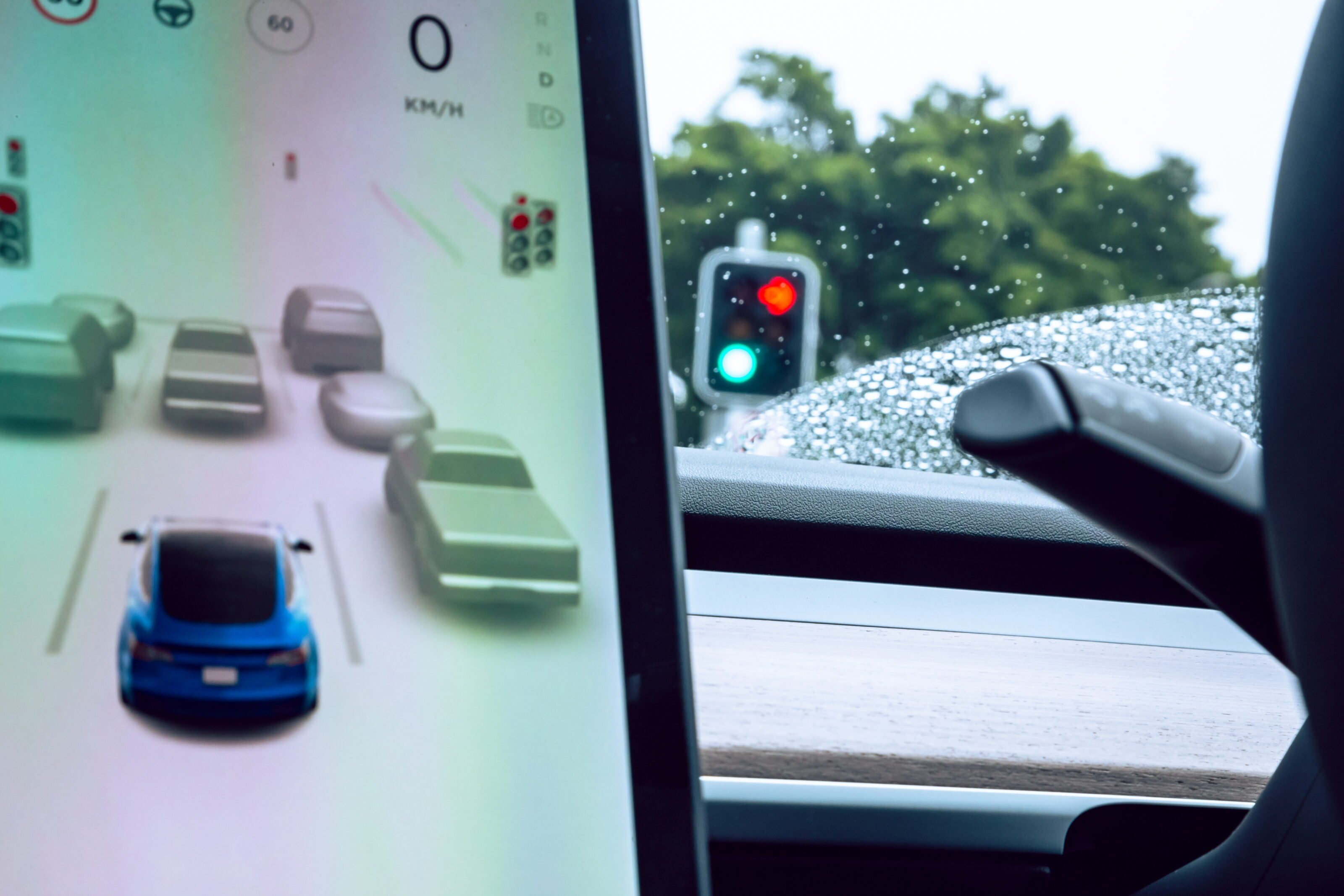
Fit and finish in the Model 3 was an improvement over the last model this author drove, though can’t match that of the Hyundai. The IONIQ 5’s perceived interior quality is on a level somewhere between a Tucson and the posh Genesis GV70.
And where the Model 3 features vegan-friendly vinyl for its seats, Hyundai’s sustainability play includes leather-appointed upholstery and trim treated and dyed with flaxseed oil, bio-painted interior surfaces and a fully recyclable door insert called paperette.
Tesla counters with luggage space. Open the IONIQ’s tailgate – and the Model 3’s distinctive semi-liftback bootlid – and respective capacities are 527 versus 561 litres.
The Hyundai has the aperture advantage, but its boot, while wide, is quite shallow and the (removable) cargo blind is positioned lower than the top of the seatbacks. The Tesla’s boot is longer and includes a deep storage well under the floor. Rear seats fold flat in both cars.
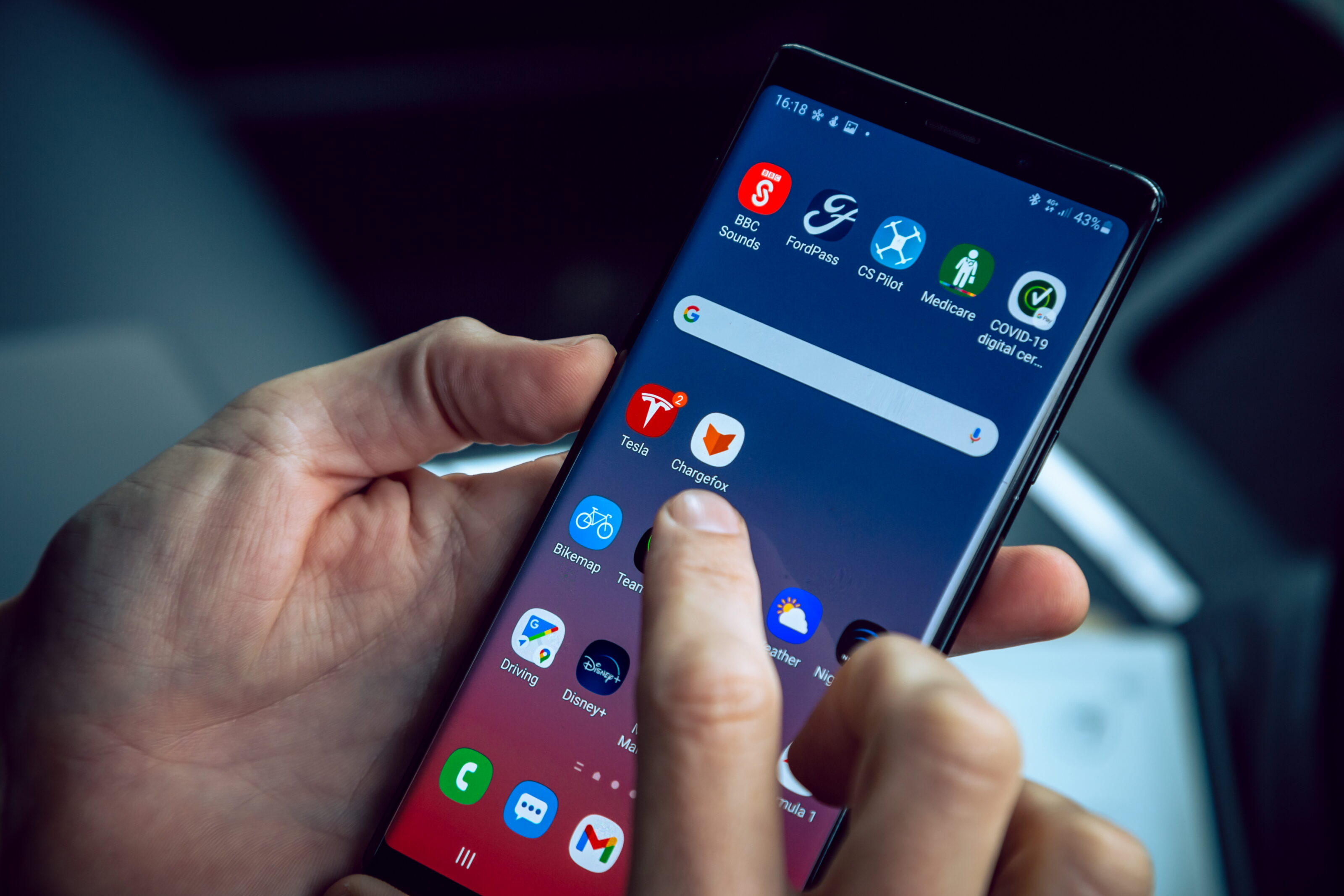
There’s an underfloor section in the IONIQ but it’s limited to storing charging cables, as well as a tyre mobility kit (an option for the Model 3) and a handy vehicle-to-load adaptor for charging things other than the car itself (see sidebar).
At the opposite ends, the Model 3’s frunk has shrunk with the introduction of a heat pump (borrowed from the related, upcoming Model Y SUV). Yet at 88 litres, it still offers more space than the 57L found under the IONIQ 5’s clamshell bonnet (shrinking to a measly 24L in the AWD version).
It’s also more easily accessed than the IONIQ’s, which gives its frunk another lid while requiring a lever in the driver’s footwell to be pulled to open the bonnet.
The Model 3’s frunk has no cover and the bonnet can be opened remotely via the clever Tesla app. The app brings next-level convenience the Hyundai can’t match – at least until the company’s Bluelink telematics is made available.
Link your smartphone with the Tesla’s key card and it becomes everything you need to lock/unlock the car, open/close the tailgate/frunk, pre-warm/cool the cabin, locate the nearest Tesla Supercharger/Destination, and even start the car.

Driving
Driving positions contrast as much as exterior designs: low-slung in the Model 3; slightly more elevated than a typical hatch in the IONIQ. That gives the Hyundai the better all-round view, though some drivers will find the steering wheel partly obscures the driver display.
Neither car provides a head-up display. It seems particularly remiss in the Tesla, which asks the driver to avert their eyes to the central touchscreen for all driving information.
The Model 3 has the tightest turning circle at 11.6 metres, though the 12.0m IONIQ hardly puts you into a world of three-point-turning hurt. However, a bigger gap exists between steering quality.
The IONIQ 5’s steering has a slightly uneven response off centre, though far worse is the over-sensitive Lane Keep Assist system that can tug at the steering wheel like some demented autonomous-driving system you’ve inadvertently engaged. While it can be switched off by holding down a steering wheel button, it’s also worth remembering it’s reactivated every time the car restarts.
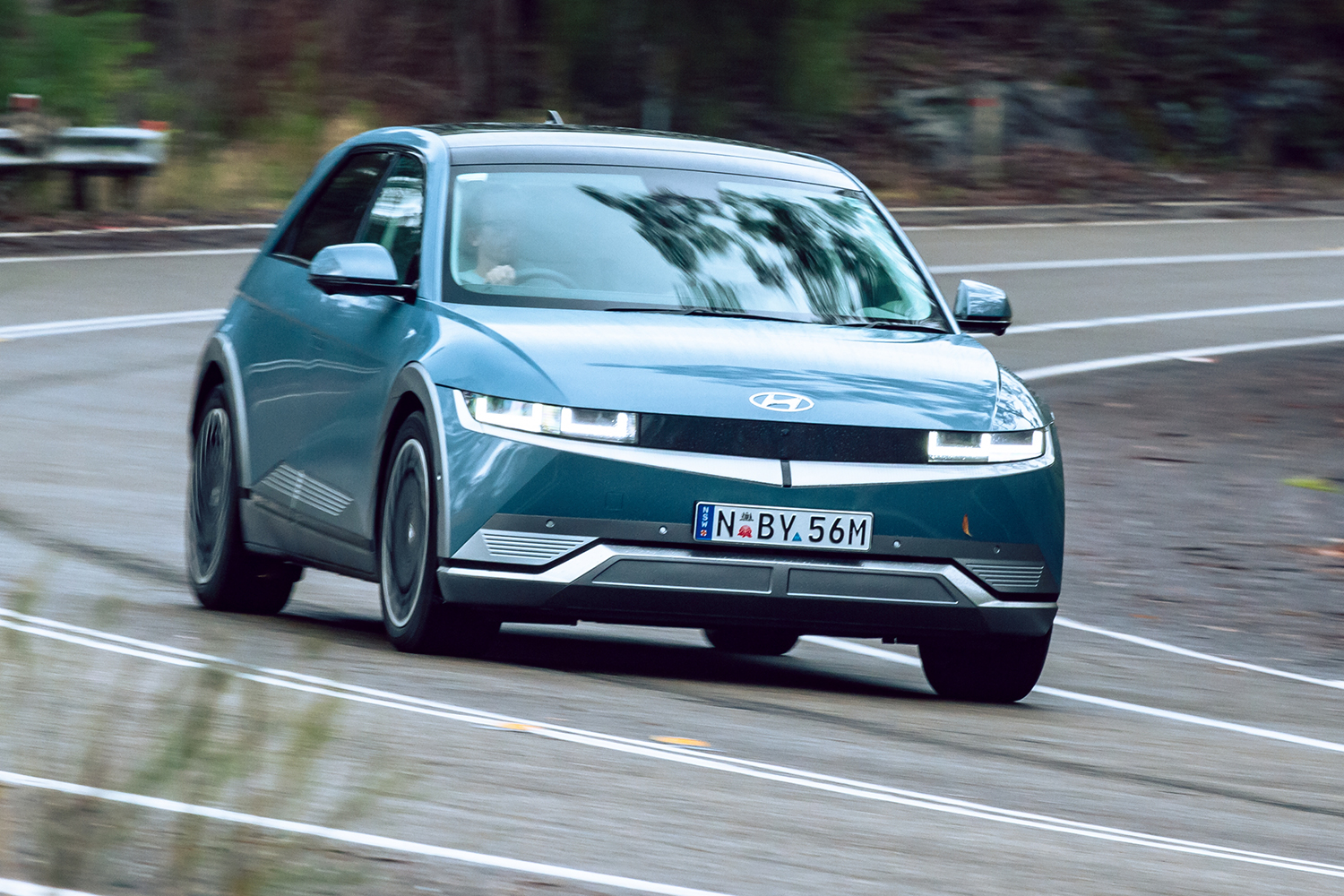
The Model 3’s compact steering wheel turns with a creamy consistency and, with just two turns lock to lock, also a directness that makes the sedan feel nimbler than the IONIQ both around town and on a winding stretch of countryside bitumen.
With its low-slung driving position, light and pointy front end, low bonnet and pronounced front wheel arches, the Model 3 attempts a preview of how an electric Porsche Cayman might drive (nonexistent steering feel aside).
The IONIQ 5 offers less for keen drivers, but neither is it a killjoy in corners. Although its two-tonne kerb weight exceeds the Tesla’s by several hundred kilos, the 72.6kWh battery under the floor helps create a relatively low centre of gravity.
There’s a nice chassis balance, with the wheel-at-each-corner stance aiding stability and the 255/45 Michelin Pilot Sport EVs generating plentiful tyre grip. On damp roads, the IONIQ’s rear end can even be coaxed into very mild oversteer.
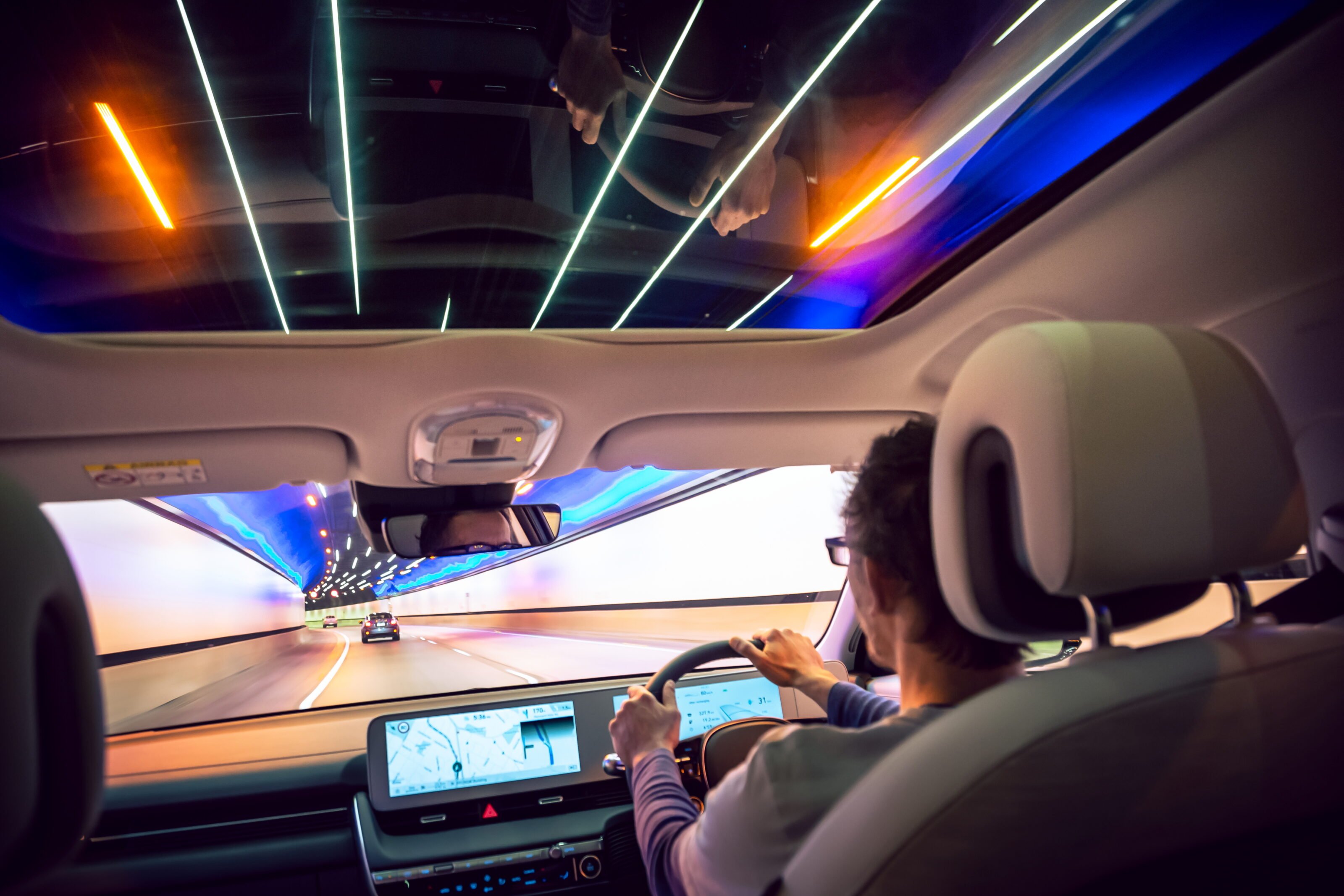
The Model 3’s Michelin Pilot Sport 4s offer impressive adhesion considering the rear rubber is asked to cope with bigger outputs. Tesla won’t divulge power and torque figures, but there’s about 239kW and 420Nm (and a 52.5kWh battery), according to the reputable EV-database.com.
Those figures seem about right from the driver’s seat, as the Tesla’s acceleration packs a decent wallop the 160kW/350Nm Hyundai can’t match.
A 5.6-second 0-100km/h claim gives the base Model 3 a near-two-second advantage that’s only overturned by the more expensive AWD IONIQ 5, which cuts the Hyundai’s sprint time from 7.4 to 5.2 seconds. Touche, says Tesla; the Model 3 Performance has a 3.3-second sprint time that’s almost absurd for a sub-$100K car. However, the Standard Range feels amply quick.
Driving modes allow drivers to adjust the torrent of instantaneous torque, even if the default settings – highest-level Standard in Model 3; mid-level Normal in the IONIQ – felt ideal to us.
Hyundai’s IONIQ 5 also provides several levels of regenerative braking via its paddles, with the highest an ‘I-Pedal’ mode for the full one-pedal-driving experience complete with hill holding.

Tesla, unusually, has axed the Model 3’s choice of regenerative braking levels. The default is a touch more aggressive than the IONIQ’s, though quickly becomes natural. When the brake pedal is required, the IONIQ’s modulates progressively where the Tesla’s is stiff.
Both EVs deliver acceptable rather than exemplary ride quality at lower speeds. The IONIQ 5’s suspension delivers the greater suppleness (and quieter tyres), though can switch between relaxed and fidgety depending on road quality and the big wheels can thud into potholes. Adaptive suspension could do wonders for the Model 3, as its over-eager damping makes for a jittery ride on uneven surfaces.
Ironically, they provide their utmost comfort on freeways, where the cars’ batteries are inevitably sapped at a faster rate. WLTP range figures are close, with the IONIQ 5’s 451km just ahead of the base Model 3’s 448km. The gap was slightly wider in our predicted ranges on test – 423km for the Tesla, the Hyundai with 442km.
The IONIQ 5 was slightly more efficient in the suburbs, with the Model 3 faring better in higher-speed, open-road driving.
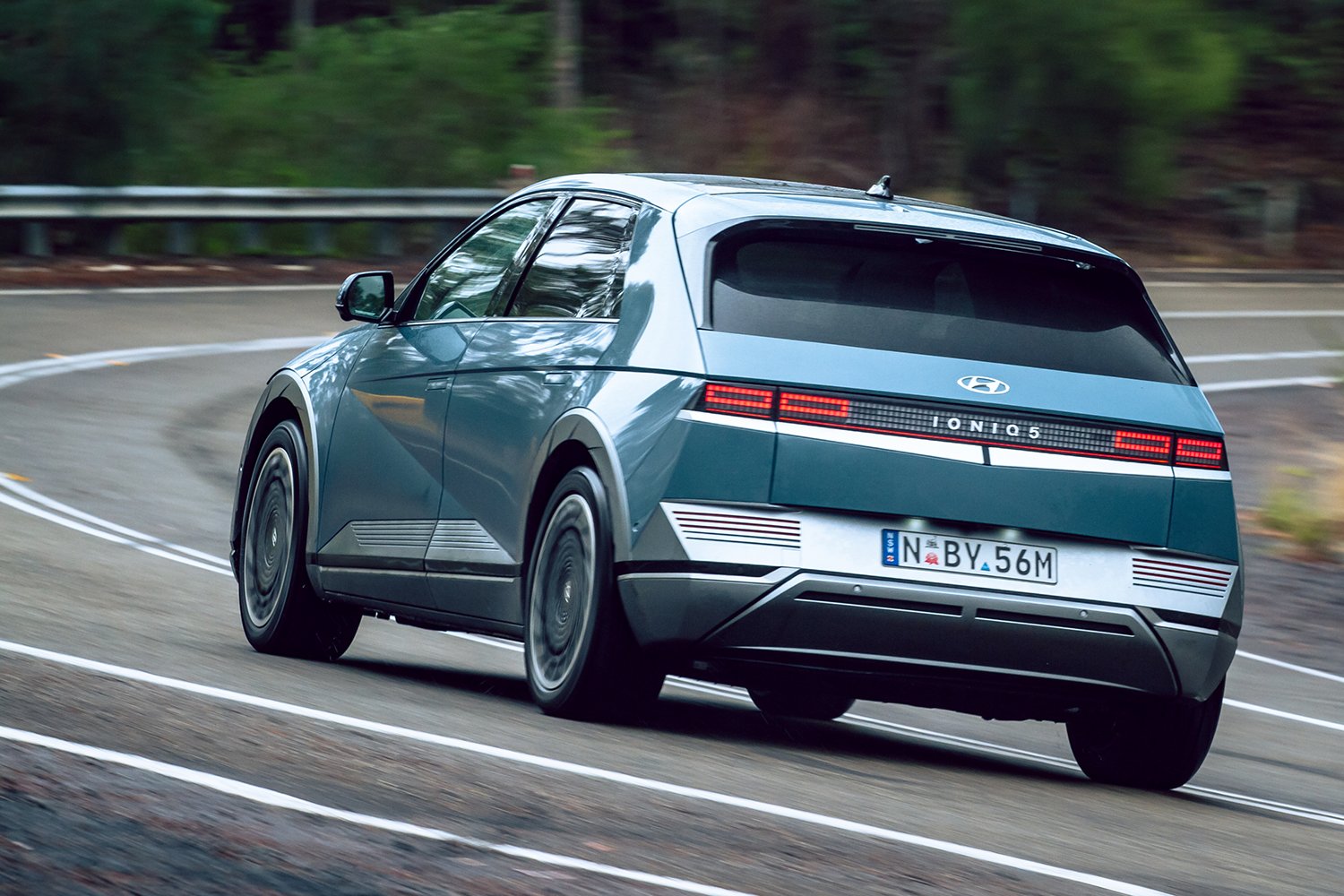
Fast-charging capability versus Australia’s reality
Just over 17 minutes. That’s all it takes to charge the IONIQ 5’s 72.6kWh battery from 10 to 80 percent thanks to the Hyundai’s 800-volt architecture that’s double the industry standard.
Establishing itself as one of the fastest-charging EVs in the world, it’s quicker even than the Porsche Taycan and Audi e-Tron GT that also use 800V technology.
Unfortunately, in Australia it’s likely to take you significantly longer to find one of the ultra-rapid 350kW DC charging stations equipped to match the IONIQ 5’s capability.
Tesla’s Model 3 isn’t exactly hampered by its 400V technology. The company’s latest V3 Superchargers perform the 10-80 per cent recharge in about 25 minutes.
Both EVs can gain 100km of range in just five minutes with high-rate charging.
For the majority of charging, owners will be using their respective AC charging capabilities – 10.5kW for IONIQ 5, 11kW for Model 3 – as supplied by garage wall chargers.
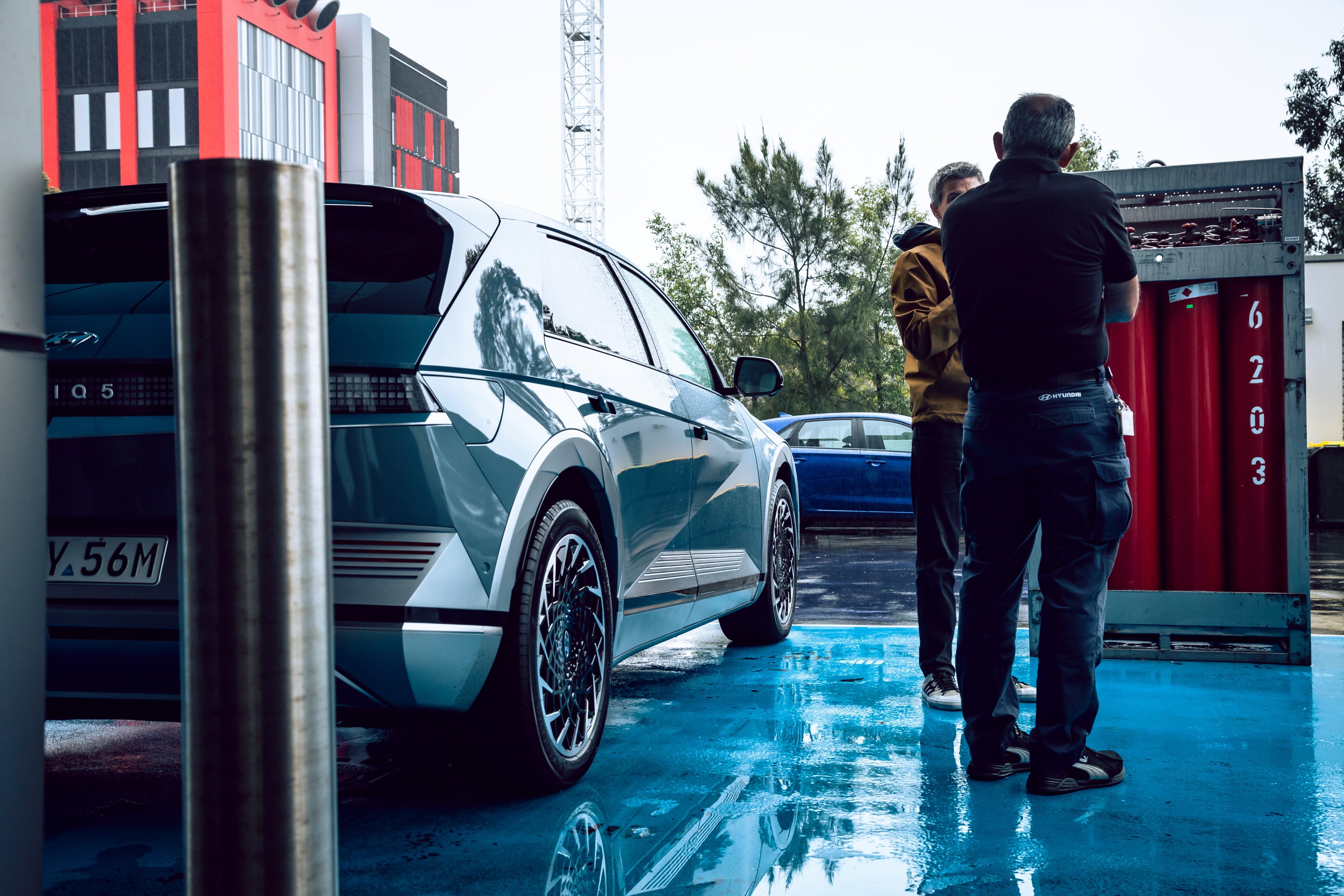
Bi-directional charging
The IONIQ 5’s second EV party trick (after its rapid-charging 800V architecture) is its Vehicle to Load (V2L) feature, which turns the Hyundai into a portable 3.6kW power source.
Plug a special adaptor into the exterior charging port and a 230V, 15-amp socket awaits your choice of power tool, camping appliance, or even laptop.
In some other markets, the IONIQ 5 is even more useful – providing a socket under the rear seat to turn the car into a rolling powerbank.
Hyundai says it’s also investigating vehicle-to-grid (V2G) compatibility, where its EVs would contribute to a household’s energy supply. The Model 3 has reportedly been engineered for bi-directional charging, but no official word from Musk yet.
NOTE: Click any of the photos here to enter our gallery
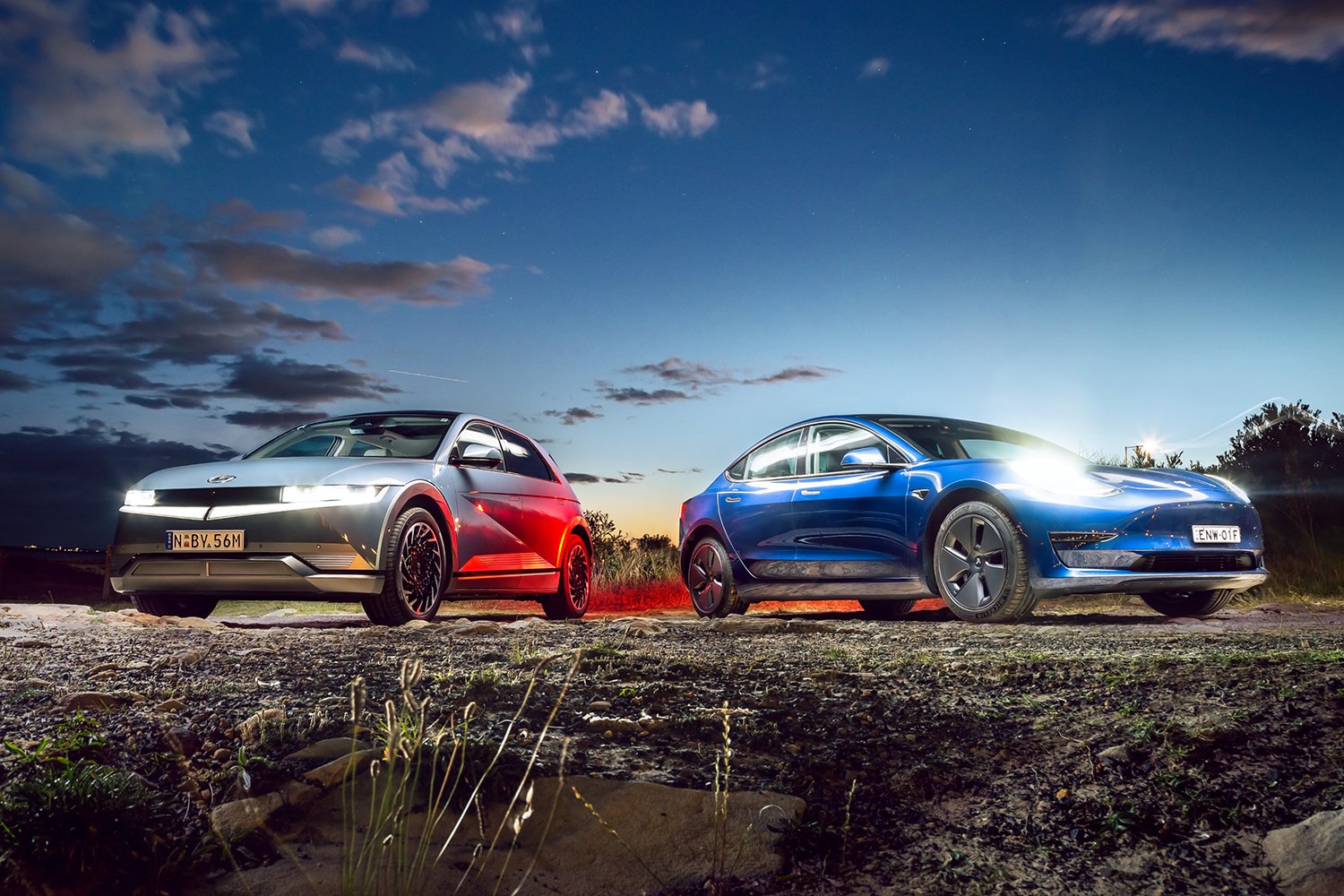
VERDICT
While electric vehicle owners will charge their cars predominantly at home, the longest component of our testing again proved how Tesla’s Supercharger network gives its cars a distance versatility (on Australia’s East Coast, at least) that will remain unrivalled until the country’s infrastructure matures significantly.
It contributes to the clever convenience of the Tesla’s all-round EV ownership experience, which is most complete with the sub-$60K, incentives-gobbling Standard Range Plus. Or buy the Long Range that’s similarly priced to the IONIQ for a near-600km range.
That the base Model 3 already delivers more performance and provides a similar range from a much smaller battery than the rear-drive IONIQ 5 also demonstrates how the Californian company’s cars remain a step ahead with their chemistry wizardry.
The IONIQ 5 is also a few technological paces behind the Model 3 in terms of infotainment, over-the-air upgrading and app functionality. Yet this is a rare Hyundai that is not just admirable but also desirable.
Besides the x-factor exterior, the IONIQ 5’s cabin impresses with abundant space and comfort; and the 800V charging capability deserves the infrastructure to match.
The AWD variant looks better value with prominent performance gains for a small range sacrifice. However, with a sub-$65K version and some missing tech still to come, there’s a sense we’re yet to see the IONIQ 5 in its most persuasive form.
Hyundai’s challenge to Tesla is likely to get only louder from here.
We recommend
-
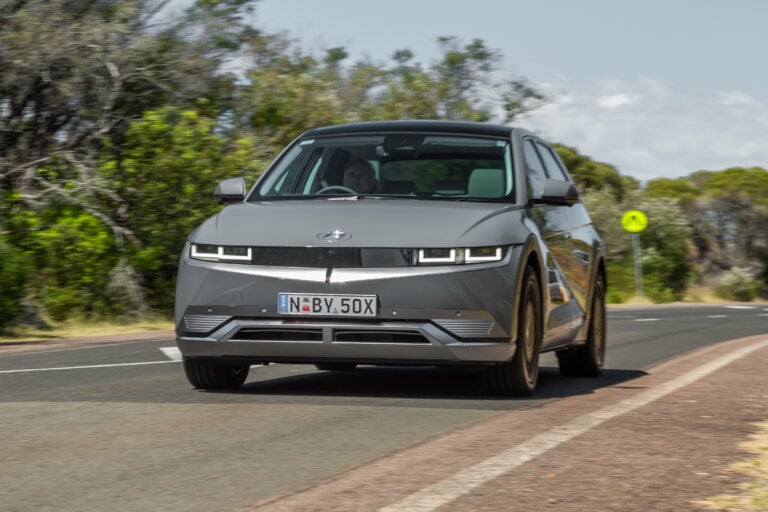 Reviews
Reviews2022 Hyundai IONIQ 5 EV review: Australian first drive
It's the most striking and intriguing car to ever come from Hyundai. We find out if the IONIQ 5 is as brilliant as it looks.
-
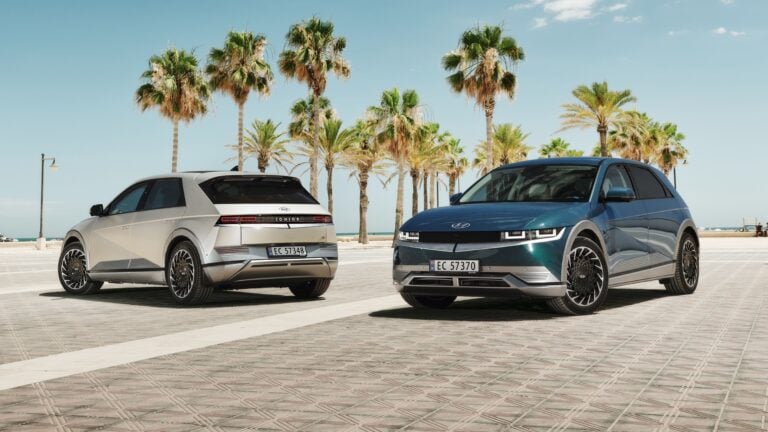 News
News2022 Hyundai Ioniq 5 pricing and features revealed for Australia
Hyundai’s bold new dedicated electric vehicle has landed, but options are limited
-
 News
News2022 Hyundai Ioniq 5 scores five-star safety rating
Highly anticipated electric vehicle passes with flying colours


